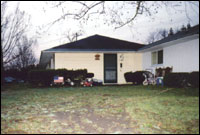Karen Strand was six in 1958 when her family moved into a house on the Camp Lejeune military base in North Carolina. It wasn’t until 2000 that she made the connection between her ongoing health problems — a bleeding ulcer at 19, thyroid and parathyroid problems, depression, and cysts and tumors that necessitated a complete hysterectomy — and the chemical-smelling water she drank and bathed in at the base for 13 years.

Haunting house: Strand’s former Camp Lejeune home.
Photo: THE STAND.
Strand and her two sisters, who have also had hysterectomies, assumed they were the victims of bad luck until three years ago, when they saw a CNN show in which representatives of the Agency for Toxic Substances and Disease Registry asked women who carried pregnancies at Camp Lejeune to come forward for a study on the health of their children. Until 1985, the ATSDR officials said, Camp Lejeune residents drank water laced with high levels of the solvent trichloroethylene (TCE), used in military operations. TCE is known to cause cancer, autoimmune disorders, birth defects, and nervous-system problems.
Strand, who now owns a day spa in North Carolina with her husband, decided to take action. In 2001, she and her sisters formed a group called Toxic Homefront Empowered Survivors Take All Necessary Defense (THE STAND). They set up a website last fall, and have since had more than 200 former Camp Lejeune residents come forward to report health problems ranging from anxiety disorder to muscle deterioration to cancer.
While these residents blame their health problems on TCE, the truth is that no formal inquiry has been made of the residents, their exposures, and their ailments, with the exception of the one ongoing ATSDR study. An update of the study’s progress is set to be released on July 16; according to spokesperson Scott Mall, research so far “shows birth defects and childhood cancers” among those who were exposed. Mall would not say whether these occurred at higher than normal rates, but said, “there was enough evidence of an issue … that we will continue the study.” ATSDR plans to complete a more comprehensive study by 2005.

Taking THE STAND to Washington: Sean Dyer, Karen Strand, Sen. John Edwards (D-N.C), and Terry Dyer.
Still, even the completed study will reveal findings only about fetuses; there has been no effort to assess the consequences of generations of Camp Lejeune residents unknowingly ingesting poisoned tap water. THE STAND hopes to change that. The group is working to compile a list of victims and is pushing the military to provide medical services to the thousands of affected families.
THE STAND bears the distinction of being the lone group in the U.S. organized around the issue of toxic pollution in military housing. But although the organization is unique, the problem it is addressing is not. Hazardous materials are found in many — some say most — military housing areas. Trichloroethylene is a common contaminant; others range from the mundane (the lead paint and asbestos frequently found in aging homes) to the exotic (unexploded ammunition, radioactive waste, and heavy metals).
Yet despite the prevalence of toxins, no government agency or environmental group has studied the risks routinely incurred by military families. No one has compiled an inventory, list, or database of contaminated housing sites. Neither the U.S. EPA nor the military nor the numerous nonprofit organizations that specialize in military environmental issues has taken up the cause of military families that, despite the national exhortation to “support our troops,” are routinely exposed to contamination in their homes.
Complicating matters is the fact that many military families are less like Strand’s (which spent more than a dozen years drinking contaminated water in a single area) and more like that of Lita Hyland, another member of THE STAND. Hyland spent the first few months of her pregnancy in 1978 at Camp Lejeune with her husband, a Marine. After her daughter was born, the family was moved to Marine housing at Camp Pendleton, near San Diego, Calif. Next they moved to military housing on Treasure Island in the San Francisco Bay.
Although it is the contamination at Lejeune that has mobilized Hyland (and that she blames for her daughter’s seizures and Crohn’s disease), records from the EPA and ATSDR show that the housing areas at both Pendleton and Treasure Island are contaminated with heavy metals. In a May interview, Hyland said she was unaware that Pendleton and Treasure Island are polluted. “I never expected this from the American government,” she said.
Homeland Offense
According to environmental advocates, cases like Hyland’s highlight one of the biggest obstacles to protecting military families from toxic exposure: Many families spend decades going from base to base, breathing, drinking, or touching a laundry list of poisons. That nomadic lifestyle makes it difficult to track where exposure occurs, what risks the average military family faces, and the cause of illnesses — not that anyone is trying to do so, or speaking out on the victims’ behalf.
Steve Taylor of the Military Toxics Project said he believes contaminated housing is a serious problem, but his group is not focused on the issue and has no funding to tackle it; the leaders of several other environmental groups echoed this sentiment. And Joyce Raezer, director of government relations for the National Military Family Association (which calls itself “the only national organization dedicated to identifying and resolving issues of concern to military families”), said that with the country at war, housing issues have taken a back seat, as her legislative staff of three seeks support for the families of deployed soldiers.
With a void of organized advocacy, Raezer said the transience of military families keeps them from speaking up for themselves. “You don’t stay in one place long enough to get organized around the issue,” she said.
Hyland said that for members of the military like her husband, challenging official policy is extremely difficult. “My husband is a Marine and he’s going to die with the uniform of the Marines. … If my husband gets an order, he follows it,” she said.

Home contaminated home: Family housing at Camp Lejeune.
Raezer and other advocates said that despite soldiers’ silence, contaminated housing is a serious problem for military families and the officials charged with their safety. “If there’s a sleeper issue on military health, this is it,” said Saul Bloom, director of Arc Ecology, a San Francisco-based environmental group that specializes in overseeing military cleanups. “It’s as important as inoculating against anthrax.”
Based on his work on closed military bases, Bloom estimated that at least half of military housing is “environmentally compromised.” But, he added, whereas the government and charitable foundations will provide funding for groups like Arc to oversee cleanups affecting the general public, addressing health risks faced by military residents is taboo.
“You’re looking at a tremendous amount of liability for the federal government, so there’s not a lot of help out there,” Bloom said. “Dealing with military issues is like the third rail of the funding world: You touch it and you don’t get money.”
Raezer said the military itself faces a parallel issue: While overall defense funding goes up, the money available for cleaning and improving housing remains inadequate. “They’re not intentionally being negligent. They just don’t have enough money,” she said. A 2000 report by the Association of the U.S. Army reads, “It would take $20 billion and 30 years to bring military housing up to par. Complicating matters is that there is little money to keep it up to par.” The report goes into detail about the decrepit state of family housing, but does not address the issue of contamination. (The military’s current effort to revitalize its moldering homes involves privatizing much of the housing. Because developers shy away from contaminated sites, Raezer and others questioned whether this gives the Pentagon a disincentive to proactively assess and address potential contamination.)
Although current government officials refused to address the issue (Department of Defense spokesperson Glenn Flood asked for a list of questions and then stopped responding to phone calls), a former Pentagon official disagreed with claims that military housing contamination is a massive problem.
Sherri Goodman, the deputy undersecretary of defense in the Clinton administration who headed the Pentagon’s environment program, said she has no way of knowing whether Bloom’s estimate of the prevalence of contamination is accurate, since no study has specifically examined the issue. “I don’t know there’s any basis for that number,” she said.
Housing contamination, she noted, is dealt with on a case-by-case basis; when risks are found, they are addressed, whether that requires drafting protocols for dealing with lead paint or negotiating with the Japanese government to curb smokestack emissions near U.S. barracks in Atsugi, Japan.
Goodman added that the current administration places less of an emphasis on studying the issue than did the Clinton administration. In fact, the position she used to occupy has been combined with that of another official, so her successor now has other responsibilities in addition to environmental management.
Major Tom to Ground Control
Sifting through documents from the EPA, ATSDR, and DoD on the 3,000-plus U.S. military bases with known contamination reveals hundreds of instances of toxins in or near the homes of service members and their families. These instances range from solvent-contaminated drinking water to radon seeping into basements to houses located next to inadequately covered hazardous waste dumps. But many of these documents lack detailed health-risk assessments for those living on the bases, either currently or in the past.

Tanks a lot: Taking aim at Camp Lejeune.
Daunted by the difficulties of tracking down transient families and piecing together an accurate study of a population that may have suffered toxic exposure at numerous sites — as well as by limited funding and staffing — government agencies rarely undertake large-scale studies of military housing, unless exposure occurs at overwhelming levels in specific sites, such as at Camp Lejeune with its drinking water. As a result, people who are seeking to learn more about military housing contamination are forced to root around for anecdotal evidence and piece together incomplete information from disparate sources.
One such person is retired Major Tom Thompson, who lived in Camp Lejeune in 1966 and 1967, after returning from the Vietnam War. His son was born in early 1967 without major parts of his circulatory system; he died after three months in the hospital. “There was nothing much left; it’s surprising he lived as long as he did,” said Thompson, who left the service in 1974 and currently lives in Moscow, Idaho.
Thompson, now 72, saw the same 2000 CNN report as did Strand. “It came as a great surprise. I’ve spent the last couple years trying to find out what the hell went wrong and who did or didn’t do what,” he said.
After spending hours a day for nearly two years seeking information on Camp Lejeune, Thompson said he is sure the military knew about the pollution in 1980 or 1981, although it didn’t shut off the contaminated wells until 1985. Tests in 1980 or 1981 for trihalomethanes — toxic byproducts of improper chlorination of water — came up inconclusive due to extremely high levels of chlorinated solvents, including TCE, Thompson said. But, he added, he is winding down his fact-finding effort because of extreme difficulties in getting information from the military.
At Camp Pendleton, one family is taking legal action against the government, claiming that negligent practices at a hazardous waste dump 40 feet from their backyard left their daughter permanently disabled. The Myers family lived at Camp Pendleton in 1999 and early 2000. The father is a Marine officer, and the mother a former Navy enlistee. Their daughter, then a healthy four-year-old, would play with the family dog in their backyard, adjacent to the Box Canyon landfill. According to their attorney, San Francisco-based Scott Allen, the Marines and their independent contractors spent six to eight months in 1999 and 2000 taking hazardous waste — including heavy metal-laden ash — from sites around Camp Pendleton to the Box Canyon dump as part of a Superfund cleanup.
Although some of the waste was dangerous enough to be restricted to a Class 1 hazardous waste dump under normal circumstances, the Navy had gotten a special federal exemption to allow disposal in the Box Canyon site, adjacent to military homes. “Ordinarily, this kind of thing wouldn’t be allowed under the law,” said Allen.

Little pink houses: Camp Pendleton family housing.
The contractors dumping at the site failed to follow basic safety procedures, Allen said, and dust containing heavy metals became airborne, ended up in the Myers’ yard, and was inhaled by the child and the dog. The girl, now seven, has permanent brain damage; neuropathy in the hands, feet, and head; alopecia universalis (loss of all body hair); and a lowered IQ. These are all symptoms of exposure to thallium, a toxic metal found at dangerous levels in the child and dog three months after they left Camp Pendleton.
She is not expected to recover; the family is now seeking unspecified damages, including money and lifetime health care for their daughter, from the federal government and its contractors. Allen said he believes the dump at Camp Pendleton continues to leach toxins, including TCE.
Allen — who has sued the military “somewhere between 10 and 20 times” over environmental issues — said he believes the problem that led to Myers’ illness has deeper roots than the contractors’ failure to take safety precautions or even the decision to permit toxic dumping next to homes. “Those are symptoms of the root problem, which is arrogance on the part of the military and its environmental policies. … They ignore the rules, they don’t take adequate precautions, and you end up with situations like these where they are dumping hazardous waste 40 feet from a housing area,” he said. Allen is currently litigating another case, where a landfill in Monterey’s Fort Ord is leaching solvents into groundwater beneath former military housing now used by college students.
Other cases abound. At Guam’s Andersen Air Force Base, groundwater has been contaminated with TCE and other chemicals. Radon enters homes through cracks created by an earthquake. In addition, according to veterans, the herbicide Agent Orange may be present throughout the base.
At Moffett Field, a former Naval base in Mountain View, Calif., the Navy initially refused to test air inside current military homes when TCE was found beneath them in 2001. After public outcry, the Navy relented and found unhealthy levels of the solvent indoors. More than six months later, it has yet to assess the possible health risks facing residents.
And at Fort Sheridan in Illinois, a study to determine whether residents were at risk from TCE exposure underscored the key problem facing military housing contamination assessments: The study calculated risk based on a few years of exposure to the chemical, since on average, families spend only three years on the base before moving on. According to Lenny Siegel of the Center for Public Environmental Oversight, the cumulative risk faced by families is not being addressed.
But with low housing allotments and an increasing cost of living, many military families have no choice but to live on base. Raezer of the National Military Family Association summed it up: “A lot of families accept the substandard housing because it’s cheap.” Unfortunately, it might prove all too costly down the line.


